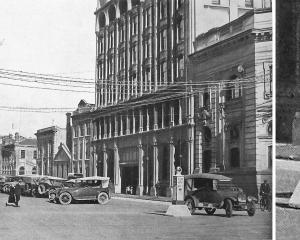
The main street in Alexandra presented a scene of animation today, when the Hon. J.G. Coates (Postmaster-general) performed the ceremony of officially opening the new building, which constitutes a distinct ornament to the town. The old post office building which gave place to the new structure was erected in 1875. It was improved from time to time to meet the growing business of the department. The new building is a combined office and postmaster’s residence. The office portion, covering the ground floor, consists of mail room, telephone exchange room, public space, postmaster’s room, the strong room, private box lobby, etc, and the postmaster’s quarters occupy the upstairs portion, and consist of dining-room, a sitting room, three bedrooms, a kitchen, a bathroom, a scullery, pantry, etc. There has been applied to the building the Van Guilder system of hollow concrete block construction. The contractors were Messrs McLeod and White. The price was £3928.
Irrigation scheme turned on
Alexandra: On turning on the water today in the Manuherikia irrigation race, the Hon J.G. Coates (Minister of Public Works) performed a ceremony of great significance to the people of Central Otago, whose chief need is a supply of water to make their land fruitful and productive. The Manuherikia scheme, it may be said, is at present the second largest in Central Otago, being exceeded only in magnitude by the Manorburn scheme, which has made a green and smiling countryside of Ida Valley. But when it has been developed to its full capacity by construction at some future date of the proposed dams further up the river, it will be easily the largest. At a point immediately above Chatto Creek the intake has been constructed, and here 100 cubic feet per second of water have been diverted from the river to irrigate an area of 11,000 acres of land lying in the triangle below, and bounded by the Clutha on one side, the Manuherikia on the other side, and completed by the race itself at a hairpin bend in the river. The official ceremony, which was presided over by Mr James Ritchie (chairman of the Vincent County Council), attracted a large attendance from Alexandra and Clyde and in fact from all parts of the province thus showing the great importance which was attached to the occasion. The race has been some seven years in the making, but of course the war period interrupted the progress of work to a considerable extent.
Dunedin should support Central
The Minister of Public Works will have been deeply impressed during his ministerial visit to Central Otago by the evidence supplied by settlers of their abundant faith in the future of the district. That their optimism is fully justified has already been proved, and what has so far been accomplished is a comparatively small indication of what ultimately lies ahead. When Central Otago has been irrigated its fertile lands will be thickly populated, and it will then be a source of great wealth to the dominion. The extraordinary thing to him, said Mr Coates, "was that the people of Dunedin had not taken a much more active part in securing irrigation for Central Otago than they had done." He paid a fitting tribute to those who had done their part in the development of the district, and there is unquestionably much yet to be done. In a large measure the prosperity of Dunedin is dependent on the efforts which are made in the country that lies behind the city, and Central Otago promises a great deal in this direction. Central Otago under irrigation promises great wealth. This fact will probably be more widely appreciated by the next generation, when the proofs of the wonderful productivity of the district are more patent to all.
— ODT, 22.3.1922












